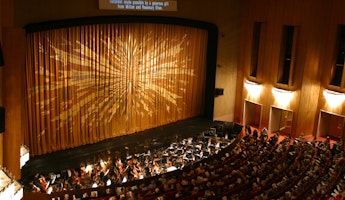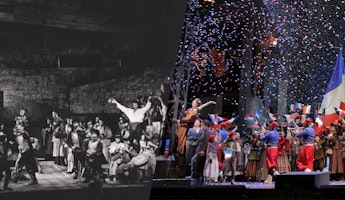Blog
October 23, 2024
From Page to Stage: "Romeo and Juliet"
There have been many attempts at bringing the Bard’s iconic lovers to the opera world, from Niccolo Antonio Zingarelli’s Giulietta e Romeo in 1796 through Vincenzo Bellini’s I Capuleti e i Montecchi in 1830 to a few 20th-century offerings as well, but none have stuck around or seen as much success as Gounod’s Romeo and Juliet (or Roméo et Juliette, in the original French). Gounod’s score truly brings the opera to life with a plethora of memorable moments such as the four duets between the lovers or Juliet’s iconic waltz aria “Je veux vivre.” But how did this beloved and classic adaptation of Shakespeare’s play come to fruition? With Romeo’s opening night just around the corner, we wanted to take a moment to go over the opera’s history and how it became an essential part of the repertoire.
Charles Gounod's opera career came when the era of epic grand opéra was coming to an end in favor of a smaller-scale genre called opéra lyrique, which led to his 1859 opera Faust becoming a giant hit. The opera, which was praised for its sophisticated elegance, premiered in Paris at the Théâtre Lyrique where it was performed an astonishing 300 times between 1859 and 1868. The success of Faust led the theater’s director, Léon Carvalho, to commission another opera from Gounod. The source material chosen was Shakespeare’s Romeo and Juliet. Gounod would team up again with the librettists for Faust, Jules Barbier and Michel Carré, and together the three of them worked to adapt the play into material suitable for Gounod’s lush music. To help fit the story better for opera, the librettists decided to play down the political intrigue of the original story in favor of focusing on the love story.
There were a few hitches in putting together the first production, like the casting of the tenor who would play Romeo, and it is believed that Gounod composed the last act twice after being dissatisfied with the original. But all things considered, the opera came together pretty smoothly after they casted Pierre-Jules Michot as Romeo. The opera premiered at the Théâtre Lyrique on April 27, 1867, and was immediately hailed as a major success. The original production took place at the same time the Exposition Universelle (world’s fair) was happening in Paris, boosting the opera’s popularity since many foreign dignitaries attended a performance of the opera. The work’s fame would even lead it to performances of a parody titled Rhum et eau en juillet (Rum and Water in July), though the details of this parody have been lost to time.
The opera made its way to London in 1867, and later that year it premiered in New York at the Academy of Music. The opera received its first full recording in 1912 with Agustarello Affre as Romeo and Yvonne Gall as Juliet.
While the opera was not the last one that Gounod composed, it was his last successful opera; his next three operas (Cinq-Mars, Polyeucte and Le Tribut de Zamora) only had brief runs and have been rarely revived after their initial runs. As for Barbier and Carré, they would take what they learned about adapting Shakespeare for opera and apply it for Ambroise Thomas’ 1868 operatic adaptation of Hamlet.
Romeo and Juliet is still performed regularly today with audiences still tapping along to “Je veux vivre” or crying along with one of Gounod’s beautiful duets. We’re beyond excited to have this opera return to our stage this November. Whether you’re a fan of the Shakespeare original or coming to the story fresh, there’s sure to be something in this opera that’ll take your breath away.








/03-cosi/_dsc0996_pr.jpg?format=auto&fit=crop&w=345&h=200&auto=format)
















